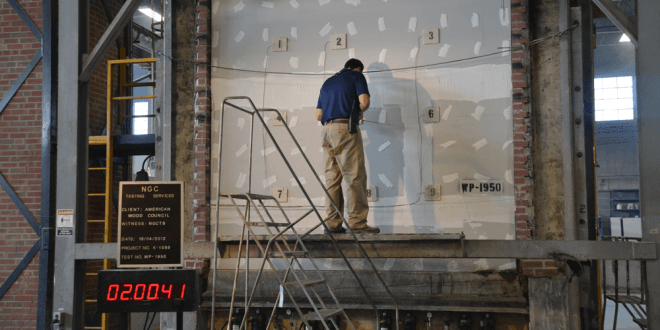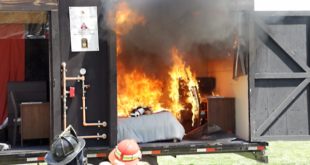
Ratings, Fire Testing and Standards – Part Two
EDITOR’S NOTE: This is part two of a six-part series that will be continued in future issues of Sprinkler Age.
Last month we initiated a discussion of how important it is for the fire marshal and members of the fire prevention bureau to understand fire testing and national standards as it relates to approving products to be put into buildings. Part 2 is a continuation of that discussion and will address some of the processes used by testing laboratories in completing various type of ratings.
Fire resistance testing of entire building assemblies and components is fundamentally a qualitative test. This is where the assembly is exposed to a prescribed condition for a specific period and observations are made of its condition to determine whether failure occurs. These observations include breaching of the assembly, flaming of the unexposed face, temperature increase of the unexposed surface, and the ability of the assembly to carry specific superimposed loads. The exposure conditions specify the furnace time and temperature relationship in the form of a standard curve.
It is unfortunate, but true, that only a very small number of fire prevention personnel have ever seen the testing apparatus and equipment used to perform fire tests. There are several good reasons for this. The first is that the equipment is expensive and there are very few locations that can afford them. Secondarily, they are complicated to utilize and do not lend themselves to simplistic evaluations of merely observing them in the process of conducting a test.
Yet, we in the fire service accept the results from these testing methods with a limited amount of concern. We need to understand them.
If it’s labeled, it’s labeled! In this column we are going to discuss some processes that define what is on a label. One of the first tests to be reviewed is the one that is used to test assemblies.
Full Scale Furnaces
Generally, the apparatus to test building materials assemblies is a Full Scale Furnace. These facilities are used in testing of building materials, fire door assemblies, floor and ceiling assemblies and fire window and/or frame assemblies in accordance with various standards.
This test procedure was first published by ASTM in 1918 as ASTM C 19-18. That first ASTM version prescribed two tests: 1) a Fire Endurance Test, and 2) a Fire Stream Test (commonly referred to as the Hose Stream Test). Similar test methods are published by Underwriters Laboratories (UL) and by the National Fire Protection Association (NFPA). Today this protocol goes by the title E119.
For additional information on this test see:
• www.astm.org/Standards/E119.htm
or type in the words “full scale fire test furnaces” in your search engine and you will see a wide variety of such devices:
• www.see.ed.ac.uk/FIRESEAT/files08/
06-Buc.pdf
• www. intertek.com/building/fire-testing
Temperature measurements are recorded by calibrated data acquisition units, which pass the readings to a computer for graphical display and storage. If the material is used vertically, the vertical furnace is facing a large roll-up door through which samples can quickly be transported to the hose stream area. The horizontal furnace is 7-ft deep and with a collar can be expanded to test columns. It will accommodate samples up to 14-ft wide by 18-ft long. Both furnaces allow for sample loading, per the applicable standard, and both are capable of following the new standard hydrocarbon curve.
Hose Stream Impact
Two important aspects of fire resistance testing are frequently misunderstood. The misperceptions surrounding the meaning of fire resistance ratings and the role of the hose stream test in assessing fire resistance is often not understood by those that have never seen the test. Understanding the basic concepts behind fire resistance and hose stream testing will provide the background needed to identify and correct misunderstandings and misinformation that may be perpetuated in the competitive arena regarding fire resistance ratings and gypsum board systems.
Hose Stream Test
The Hose Stream Test is divided into 1) a “primary” or “standard” method and 2) an “optional program” method. The optional program is referred to as an “exception” in the NFPA version. The standard method states that: “a duplicate specimen (is) subjected to a fire exposure test for a period equal to one half of… the resistance period of the Fire Endurance Test, but not for more than one hour.” The duplicate specimen is then immediately subjected to the impact, cooling, and erosion effect of a stream of water from a fire hose at a pressure and for a duration of time specified in the test method. If no significant amount of water passes through the test specimen, the first endurance time of the first specimen becomes the fire rating for the system.
The duration of the hose stream exposure is a function of the fire endurance period of the original specimen and is keyed to the fire-resistance rating of the system being tested; i.e., the longer the rating, the longer and more severe the hose stream exposure. The “optional” program, which can only be used if both the testing laboratory and the test sponsor agree, is to administer the hose stream to the same specimen used for the Fire Endurance Test without the need for, and added cost of, constructing and burning a duplicate specimen as required by the standard method.
Fire Endurance
The Fire Endurance Test subjects a specimen to a prescribed fire until certain conditions are met that indicate the end of the endurance test. This period of time is known as the “resistance period” of the Fire Endurance Test. All fire resistance rated systems, regardless of the materials from which they are built, are tested using this Fire Endurance Test. This is where the terms 1 hour, 2 hour or 4 hour come from. This is what is measured in the laboratory. It may or may not be what we see in the field as firefighters.
Summary
Fire resistance, containment, and prevention are important aspects of building and structure design. The ability of a loaded structural material to retain its strength can provide additional valuable time for building evacuation.
Fire resistance tests determine the behavior of an element of construction when subjected to defined heating and pressure conditions which may be encountered in a fully developed fire. Fire resistance is the property of composite constructions; it is a test of structures rather than individual materials and, consequently, the tests tend to be large in scale and complexity. The test specimens are representatives of the items that go to make up buildings: doors, walls, floors beams, columns and ceilings, etc. Fire resistance tests are also required in codes and regulations in both the marine and transport sectors.
I know it’s not the same as the classroom lab experiments you experienced in high school… but it is the way we describe materials.
To be continued….
 ABOUT THE AUTHOR: Ronny J. Coleman is currently the president of Fireforceone. He is a past president of the IAFC and CFAI. Over his lifetime, he has received numerous awards including the AFSA’s 1989 Henry S. Parmelee Award, the 2011 Mason Lankford Award from the Congressional Fire Services Institute, and the Tom Brennan Lifetime Achievement Award from Fire Engineering in 2014. He continues as a contributor to the fire service in many ways.
ABOUT THE AUTHOR: Ronny J. Coleman is currently the president of Fireforceone. He is a past president of the IAFC and CFAI. Over his lifetime, he has received numerous awards including the AFSA’s 1989 Henry S. Parmelee Award, the 2011 Mason Lankford Award from the Congressional Fire Services Institute, and the Tom Brennan Lifetime Achievement Award from Fire Engineering in 2014. He continues as a contributor to the fire service in many ways.

 Sprinkler Age A Publication of the American Fire Sprinkler Association
Sprinkler Age A Publication of the American Fire Sprinkler Association
